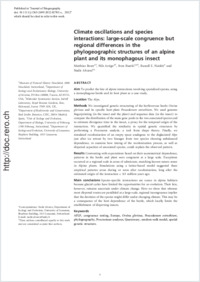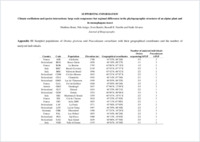Climate oscillations and species interactions: large-scale congruence but regional differences in the phylogeographic structures of an alpine plant and its monophagous insect
- Borer, Matthias Museum of Natural History Neuchâtel, Switzerland
- Arrigo, Nils Department of Ecology and Evolutionary Biology, University of Arizona, Tucson, USA
- Buerki, Sven Molecular Systematics Section, Jodrell Laboratory, Royal Botanic Gardens, Kew, UK - Department of Biodiversity and Conservation, Real Jardin Botanico, Madrid, Spain
- Naisbit, Russell E. Unit of Ecology and Evolution, Department of Biology, University of Fribourg, Switzerland
- Alvarez, Nadir Department of Ecology and Evolution, University of Lausanne, Switzerland
-
17.04.2012
Published in:
- Journal of Biogeography. - 2012, vol. 39, no. 8, p. 1487-1498
AFLP
congruence testing
Europe
Oreina gloriosa
Peucedanum ostruthium
phylogeography
Procrustean analyses
Quaternary
random walk model
spatial genetic structure
English
Aim To predict the fate of alpine interactions involving specialized species, using a monophagous beetle and its host plant as a case study.Location The Alps.Methods We investigated genetic structuring of the herbivorous beetle Oreina gloriosa and its specific host-plant Peucedanum ostruthium. We used genome fingerprinting (in the insect and the plant) and sequence data (in the insect) to compare the distribution of the main gene pools in the two associated species and to estimate divergence time in the insect, a proxy for the temporal origin of the interaction. We quantified the similarity in spatial genetic structures by performing a Procrustes analysis, a tool from shape theory. Finally, we simulated recolonization of an empty space analogous to the deglaciated Alps just after ice retreat by two lineages from two species showing unbalanced dependence, to examine how timing of the recolonization process, as well as dispersal capacities of associated species, could explain the observed pattern.Results Contrasting with expectations based on their asymmetrical dependence, patterns in the beetle and plant were congruent at a large scale. Exceptions occurred at a regional scale in areas of admixture, matching known suture zones in Alpine plants. Simulations using a lattice-based model suggested these empirical patterns arose during or soon after recolonization, long after the estimated origin of the interaction c. 0.5 million years ago.Main conclusions Species-specific interactions are scarce in alpine habitats because glacial cycles have limited the opportunities for co-evolution. Their fate, however, remains uncertain under climate change. Here we show that whereas most dispersal routes are paralleled at a large scale, regional incongruence implies that the destinies of the species might differ under changing climate. This may be a consequence of the host dependence of the beetle, which locally limits the establishment of dispersing insects.
- Faculty
- Faculté des sciences et de médecine
- Department
- Département de Biologie
- Language
-
- English
- Classification
- Biological sciences
- License
- License undefined
- Identifiers
-
- RERO DOC 29073
- DOI 10.1111/j.1365-2699.2012.02703.x
- Persistent URL
- https://folia.unifr.ch/unifr/documents/302341
Other files
Statistics
Document views: 110
File downloads:
- nai_cos.pdf: 216
- nai_cos_sm.pdf: 128

